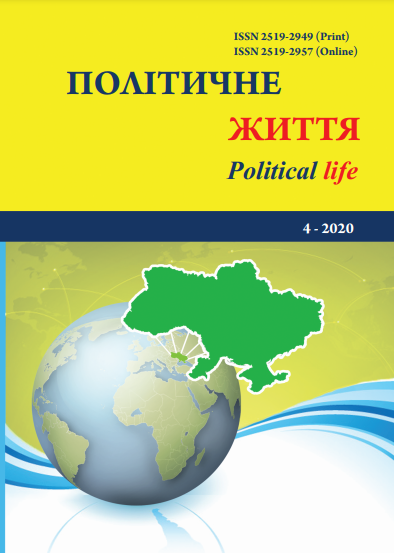Countries of the South Caucasus in the focus of the eastern policy of the European Union
DOI:
https://doi.org/10.31558/2519-2949.2020.4.15Keywords:
European Union; Eastern policy; Armenia; Georgia; Azerbaijan; South Caucasus; Russia; Eastern partnershipAbstract
Peculiarities and main stages of the European Union modern eastern policy formation are considered, including the countries of the South Caucasus – Armenia, Azerbaijan, and Georgia. The reasons have been brought to light for the weak presence of the EU in the region of the South Caucasus in the early 90s of the XXth century, in particular, the lack of understanding by European partners of the problems of this region; recognition of them as a sphere of influence of Russia; lack of tools in the EU to conduct foreign and security policy in the region, as well as to resolve conflicts there. The grounds for including the countries of the region in the sphere of the EU foreign policy are determined, such as the EU energy security; democratization of the South Caucasus as an important component of European security; reaching a compromise between European partners on strengthening the EU’s presence in the post-Soviet space. Emphasis is placed on the peculiarities of the foreign policy priorities of Armenia, Georgia, and Azerbaijan concerning the European Union, and the formation of cooperation, major achievements, problems, and challenges. It has been proved that from the very beginning of the institutionalization of the modern EU eastern policy, the countries of the South Caucasus have had different interests in cooperation with European partners. Thus, Azerbaijan – the development of economic cooperation with the EU, mainly in the energy sector and the restoration of the territorial integrity of the state; Armenia – investment and financial assistance from the EU, support for peace and stability in the Nagorno-Karabakh region; Georgia – strengthening the European movement, restoring territorial integrity, stabilization of the internal situation and in the South Caucasus in general. It is argued that it is the high level of conflict in the region that is the main obstacle to the full implementation of the EU regulatory force in the South Caucasus region. It is concluded that the main limitations of the EU’s Eastern policy towards the countries of the South Caucasus are the lack of a clear strategy towards the South Caucasus, the lack of political and security cooperation, and a certain exclusion of the EU from resolving regional conflicts there. Besides, the effectiveness of the EU’s eastern policy in the South Caucasus will largely depend on the influence of third parties, mainly Russia.
References
Vijna v Nagirnomu Karabaxu vnosyt pyat zmin v liniyi na mapax. URL: https://www.unian.ua/world/ viyna-v-nagirnomu-karabasi-naslidki-viyni-vnesut-p-yat-zmin-u-liniji-kordoniv-novini-svitu-11222462.html (data zvernennya: 20.12.2020).
Galstjan N. Juzhnyj Kavkaz v prostranstve normativnoj geopolitiki Evropejskogo sojuza. Vzgljad iz Erevana. Vostochnoe partnerstvo: celi – opyt – vyzovy Analiz processa implementacii v gosudarstvah ohvachennyh programmoj. Krakіv, 2013. S. 341-364.
Gusejnov F. Vostochnoe partnerstvo kak instrument mezhdunarodnogo sotrudnichestva Azerbajdzhanskij obrazec. Vostochnoe partnerstvo: celi – opyt – vyzovy Analiz processa implementacii v gosudarstvah ohvachennyh programmoj. Krakіv, 2013. S. 307-317.
Madoyan K. Virmeniya za dva roky pislya Vilnyusa: mizh Yevrosoyuzom i vijnoyu. URL: https: //www.eurointegration.com.ua/articles/2015/12/14/7042163/ (data zvernennya: 10.11.2020).
Nagornyak I. Iniciatyva YeS "Shidne partnerstvo". Instytucijni osnovy, zavdannya ta perspektyvy zmin. Naukovi zapysky Instytutu politychnyx i etnonacionalnyx doslidzhen im. I. F. Kurasa NAN Ukrayiny. 2017. Vyp. 2. S. 346-365.
Snigyr O. Otsinka aktualnogo zovnishnopolitychnogo poryadku dennogo v regioni Pivdennogo Kavkazu (Gruziya, Virmeniya, Azerbajdzhan). URL: https://www.academia.edu/38046633 (data zvernennya: 22.12.2020).
Sxidne partnerstvo YeS: dodatkovi mozhlyvosti dlya yevrointegraciyi Ukrayiny / I. Gazizullin, M. Gonchar, O. Kolomiyecz [ta in.]. Ahenstvo «Ukrayina». Kyiv, 2009. 84 s.
Shapovalova O. Normatyvna syla Yevropejskogo Soyuzu v Sxidnij Yevropi. Naukovyj visnyk Dyplomatychnoyi akademiyi Ukrayiny. 2009. Vyp. 15. S. 187-194.
Juzhnyj Kavkaz – na zadvorkah vneshnej politiki ES. URL: https://www.dw.com/ru (data zvernennja: 08.12.2020).
Barburska O. Polityka wschodnia Unii Europejskiej jako część skladowa polityki zagranicznej UE. Warszawa: ASPRA-JR, 2018. 484 s.
Cianciara Agnieszka K. Partnerstwo Wscodnie 2009-2014. Geneza, funkcjonowanie, uwarunkowania. Warszawa: ISP PAN, 2014. 177 s.
Europa Wschodnia i Południowy Kaukaz w polityce Unii Europejskiej. Szczecin: Uniwersytet Szczeciński, 2011. 187 s.
Legucka A. Polityka wschodnia Unii Europejskiej. Warszawa: Akademia Obrony Narodowej, 2008. 180 s.
Piskorska B. Soft power w polityce UE wobec panstw Partnerstwa Wschodniego. Lublin: KUI, 2017. 597 s.
Wizja rozwoju Partnerstwa Wscodniego po 2020 roku. Warszawa, 2019. 44 s.
Ziółkowski M. Projekt: Ukraina. Kraków: Zakład Graficzny Colonel, 2009. 154 s.

